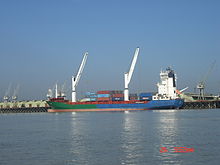- Port of Chittagong
-
The Port of Chittagong is the largest seaport in Bangladesh, located by the estuary of the Karnaphuli River in Patenga, near the city of Chittagong. It is a deepwater seaport dominated by trade in containerised manufactured products (especially garments, jute and jute goods, leather products, fertilisers and seafood), raw materials and to a lesser extent passengers. It is one of the two main sea port of Bangladesh - most of the export and import of the country are handled via this port. Window berthing system was introduced at the seaport on August 6, 2007, enabling the sea port to provide the arrival and departure times of all ships. Two berths at the port terminal are kept in reserve for emergency. In 2006 the port handled 27 million tonnes of cargo and 0.8 million tonnes of containers [1]. The port handled 1.5 million TEUs (twenty equivalent units) containers in 2010-11, up from 12.12 lakh TEUs in the previous year, according to the CPA Traffic Department.
Contents
Early history
The history of Chittagong port dates back to the fourth century B.C. Malayan history chronicles the journey of the sailor Buddha Gupta from Chittagong to Malaya in the 4th century B.C.[2] The Periplus of the Erythraean Sea documents the existence of Chittagong port in the ancient times. Chittagong derives its name from the Arabic word Shetgang (Shet means delta and Gang the river). The Arab traders considered Chittagong to be the delta of the Ganges.
Chittagong port has been mentioned in the works of Ptolemy, Fa-hien, Hieu-en tsng, lbn Battuta. This was an important port used by the traders from the Middle East, China, Turkey, Europe to trade with this part of the world.
During the 9th century the activities of the port increased tremendously as the Arab traders started using the port as their base port. They used to call the port "Samunda". The port was under their control at the time.
The 16th century saw the arrival of the Portuguese. Joaoda Silveria was the first Portuguese Captain to reach the port. He arrived with his ship “LOPO SOANA” in 1517. The Portuguese named the Port PORTE GRANDE (a great Port ). The records show that the Porte Grande offered easy access and safe anchorage to ships of 20 feet draught.
It remained a port during Moghul time. Later in early 19th century the British took control of the Chittagong port.The port of Chittagong became a natural outlet for the Northeastern regions of the then British-India that led to the enactment of Port Commissioner’s Act of 1887. At that time the facilities of the port consisted of five wooden and one pontoon jetties. In the year 1889-90 the port handled exports totalling 1.25 lac tons [3].
Facilities
For Ocean-Going Vessels:
General Cargo Berths ----------------- 12 Container Berths --------------------- 8
Specialised Berths for Bulk handling:
Dolphin Oil Jetty (For POL) ---------- 1 Grain Silo Jetty --------------------- 1 Cement Clinker Jetty ----------------- 1 TSP Jetty ---------------------------- 1 CUFL Jetty --------------------------- 1 KAFCO Urea Jetty --------------------- 1 Ammonia Jetty ------------------------ 1
Repair Berths
Dry Dock Jetty ----------------------- 2
Mooring Berths
River Mooring ------------------------ 10
For Inland Coasters and Vessels:
Jetty Berths (For (POL) -------------- 1 Concrete Berth (For Grain Handling) -- 1 Pontoon Berths (For POL) ------------- 3 Pontoon Berths (For Cement) ---------- 1 Single Point Mooring ----------------- 10
See also
References
- ^ "cpastat". http://www.cpa.gov.bd/statistical_info.html.
- ^ "cpa". http://www.cpa.gov.bd/history.html.
- ^ "dailystar". http://thedailystar.net/2005/07/01/d507011902101.htm.
External links
Categories:- Ports and harbours of Bangladesh
- Chittagong
- Karnaphuli River
Wikimedia Foundation. 2010.

